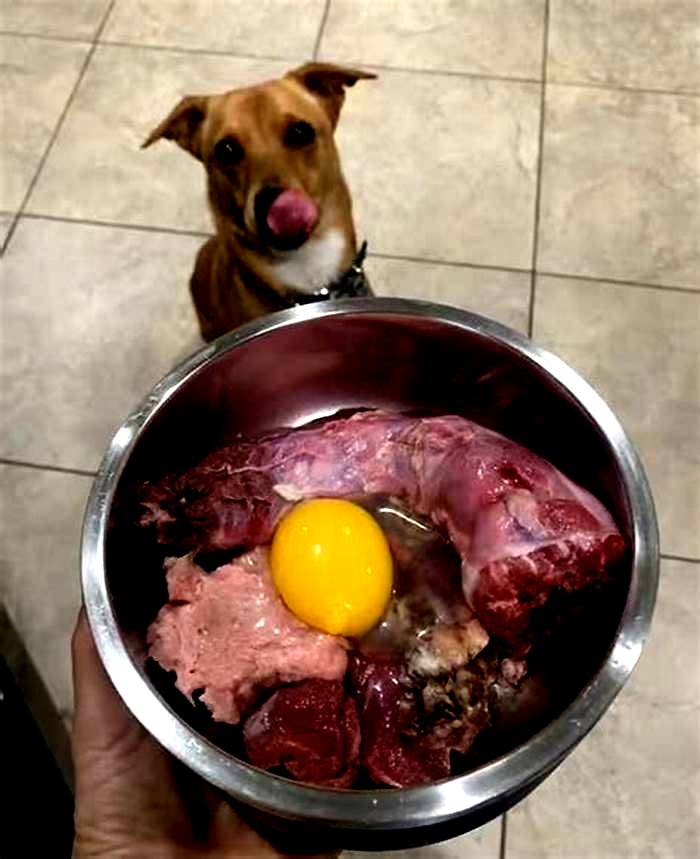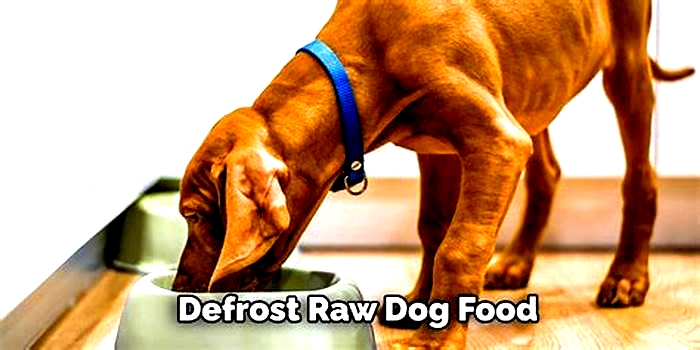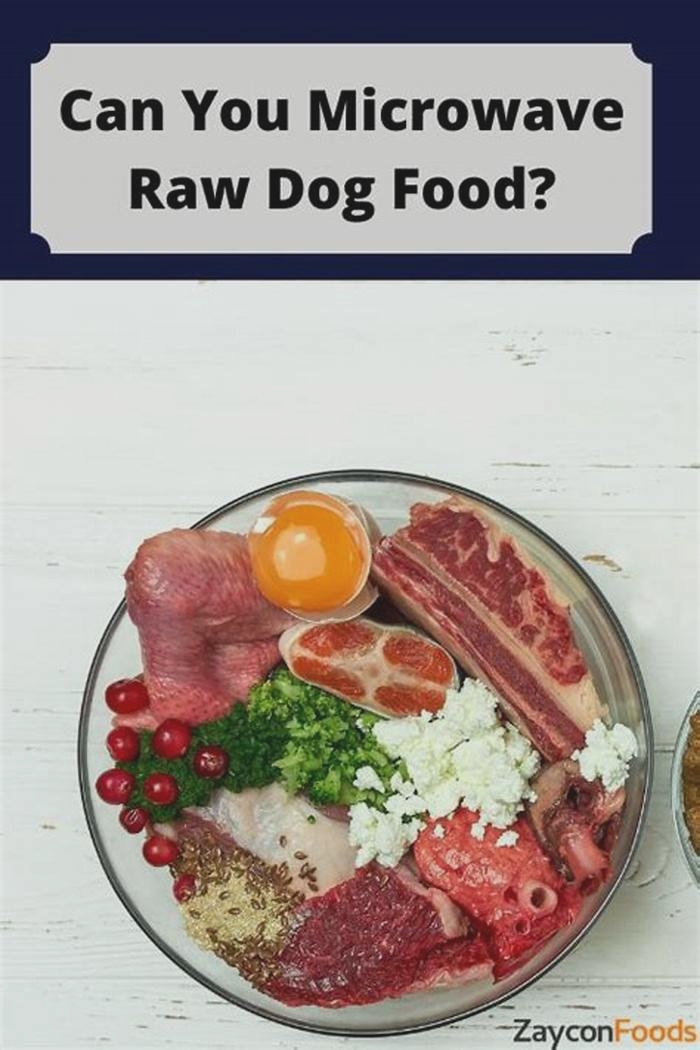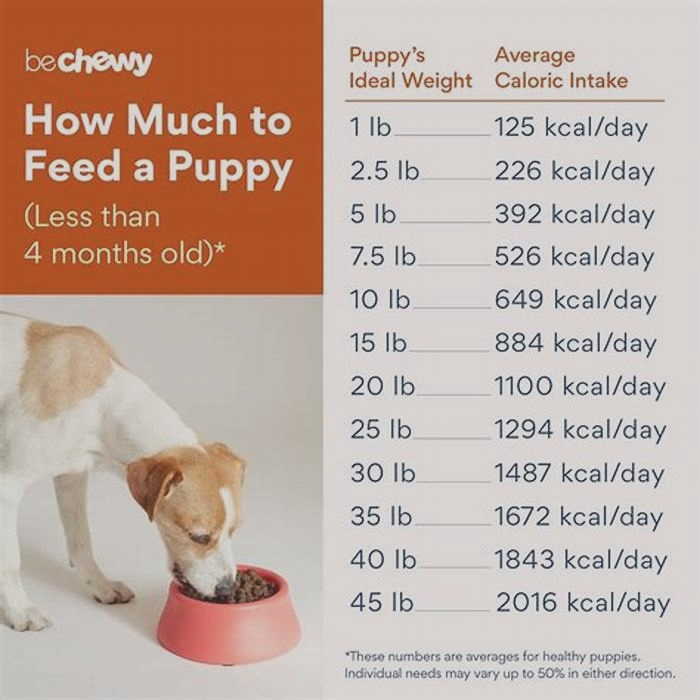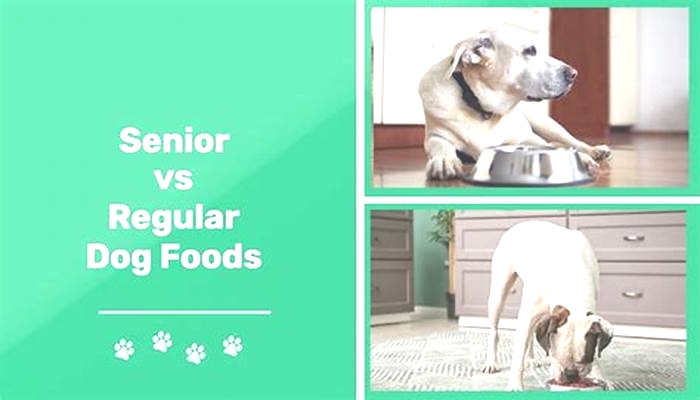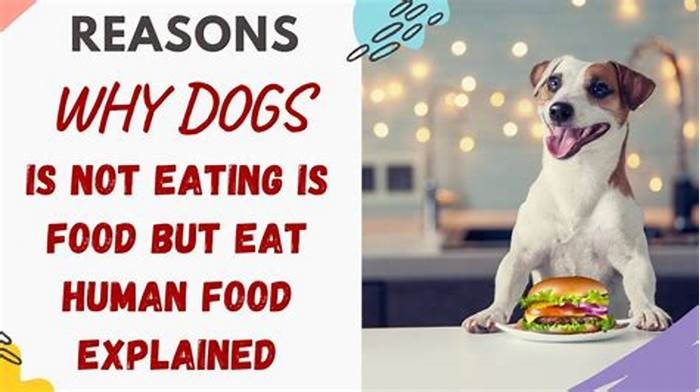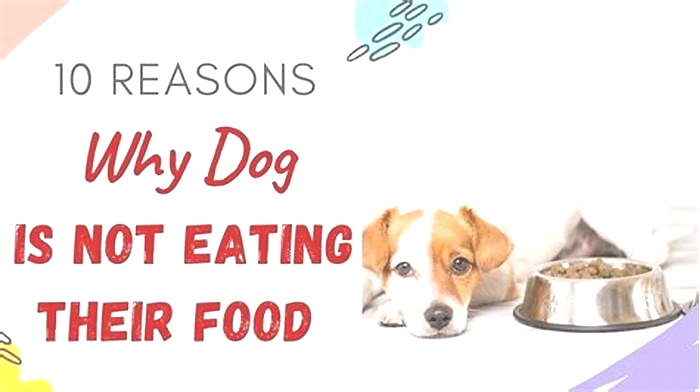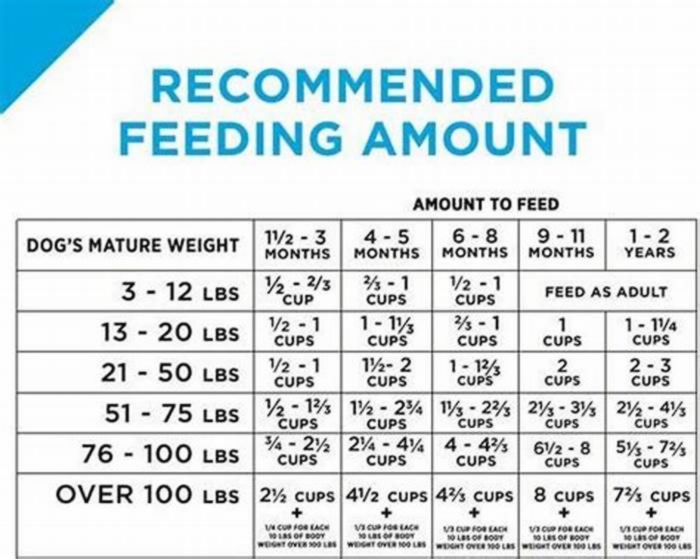Is it OK to defrost raw dog food in microwave
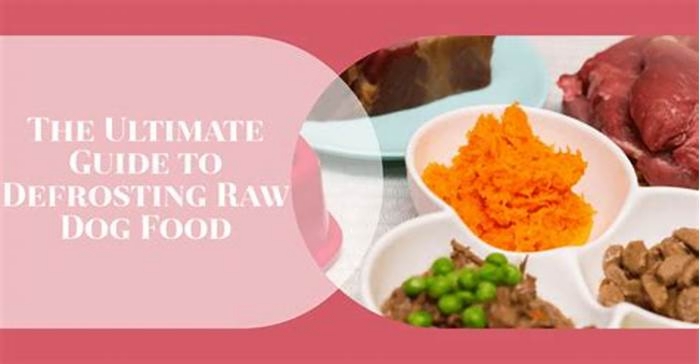
The Quickest Way to Defrost Raw Dog Food
Its 8:45 am, youre late for work, and you forgot to defrost your raw pet food. No worries, your dog doesnt have to go hungry.
So, whats the quickest way to defrost your raw dog food? You can defrost a small to moderately-sized block of meat within 10 to 20-minutes by rinsing it under hot water. Youll need a large pan, Ziplock bag, and running hot water to do this.
The Pan Rinse Method For Defrosting Raw Dog Food:
- Run the hot water in your kitchen sink ideally, the water should be too hot to hold your hand under it longer than a second
- Place the meat in a Ziplock bag (if it isnt sealed already)
- Place your block of meat in a metal pan, bowl, or tray deep enough to cover its entire mass
- Run the water over the block of meat if possible, the water shouldnt be directly hitting the meat (but the water surrounding it)
- Double-check the meat is 100% submerged in the water youll most likely have to weigh it down with a heavy object
- Run the water for 10 to 20-minutes, periodically checking to make sure the meat is still submerged
- Carefully remove the meat and immediately store anything unused into the refrigerator (not the freezer)
Is The Pan Rinse Method the Safest Way to Defrost Raw Dog Food?
Im not going to lie I forget to thaw out my food ahead of time more than I care to admit. At this point, Ive used the Pan Rinse Method dozens of times and my dogs have never had any issues, such as vomiting or diarrhea.But, a major concern with this method is the spread of dangerous pathogens, and hot temperatures will slightly cook the meat, which is like a nice weekend getaway for bacteria. This is why I recommend putting any unused meat inside the refrigerator as soon as possible. Dogs, by nature, are much better at processing bacteria than we are however, YOU KNOW YOUR DOG BETTER THAN ANYONE. If your dog regularly gets sick/needs a trip to the vet, the Pan Rinse Method probably isnt for you.
That said, I dont recommend using this method for your own food unless you plan on eating all of the meat in one sitting (which should cook out the bacteria). We just dont have the stomach for it.
Is There an Alternative Way to Quickly Defrost Raw Dog Food without Hot Running Water?
Perhaps your kids (or inconsiderate roommate) used up all the hot water this morning? No worries, theres another way but, it will add about 10 more minutes to the process and require more attention.
- Find a pan larger than the block of meat you need to defrost and fill it with water
- Heat the pan on medium on your stovetop for about 10-minutes it should be at a pre-boil, which is when you just begin to see bubbles
- Place the sealed block of meat in the pan, and submerge with a wooden or rubber spoon (Important, we do not want to weight the food down and walk away because it will overcook the bottom)
- Carefully remove the meat after 10 to 15-minutes immediately place any unused meat in your refrigerator (again, not the freezer)
Whats the Safest Way to Defrost Raw Dog Food?
Hands down, the safest way to defrost raw dog food is to take it out of the freezer and put it directly into the refrigerator. This method can take 12 to 36-hours depending on how much meat were talking about.
The next best way is to repeat the exact steps at the top of this article, except with room temperature water. It can take up to an hour to defrost your meat this way, but it is effective and safer (if bacteria is a concern).
Last, simply taking the meat out and letting it sit at room temperature will take somewhere between 2 and 4-hours to defrost. However, this is my least favorite option, because I have a tendency to forget about it.
And any meat that has been sitting at room temperature for more than two hours should be thrown out.
How Long Will Defrosted Raw Dog Food Stay Good in the Fridge?
If you used the Drowning Pan Method or the stovetop method, youre not going to want to keep that meat in the fridge any longer than 3 days. Remember, those methods lightly cook the meat, which may make it bacteria more of a concern.
If you dont think you can use all of the meat in less than 4 days, then, no problem simply let it sit in the fridge for a few hours, until its 100% defrosted, and stick it back in the freezer.
Everything else can generally stay up to a week. Use your best judgment though if it smells funny, its time to go.
Why Cant I Just Microwave Raw Dog Food?
I cant stress this enough: NEVER MICROWAVE RAW DOG FOOD! NEVER!Besides the plethora of studies proving microwaves kill essential nutrients in food (which, kind of defeats the purpose of going raw) microwaving raw food can be outright deadly.
A well-balanced raw dog meal most likely has bones in the mix. Raw bones are soft and chewy (relatively) because they still have water and nutrients in their cells; however, when you microwave bone, you are sucking out all that delicious soft chewiness, and youre left with brittle, dry, bone.
Imagine eating a bowl of wood splinters. Thats the equivalent of your dog eating microwaved bone and is a leading cause of pet deaths a la internal bleeding.
Yes, microwaves are quick and easy but they have no place in raw pet food.
Cant My Dog Just Eat Frozen Raw Dog Food?
Heck ya, your dog can!
In fact, feeding your dog its raw meal frozen can be a great 30-minute distraction while youre off to work or running errands. Its even beneficial for teeth cleaning.
There are a couple of challenges to feeding your dog frozen raw meat:
1 Unless youve properly prepared beforehand, you probably dont have the right meal size for your dog. Otherwise, you probably wouldnt be reading this.
And it is extremely dangerous to break apart frozen meat with a knife. I cant imagine how many emergency rooms visits this warrants per year.
But, there is nothing wrong with feeding your dog double their usual meal and skipping dinner. Read the next section and my post Why Your Dog Skipping a Meal (or two) Isnt a Big Deal to learn more.
2 Unless you introduced frozen raw food at a young age, or this is something you do regularly, your dog probably wont know what to do with a frozen piece of meat. And the last thing you want to do is leave raw meat in your house unsupervised thats how pets and people get sick.
If this is something youd like to do, Id recommend starting slowly. Introduce your pup to treat-size portions of frozen raw dog food, and scale up from there.
I Dont Have Enough Time to Defrost the Raw Food Is it Okay for my Dog to Skip a Meal?
It is absolutely okay if your dog misses breakfast from time to time. In fact, all three of my dogs skip at least two meals a week.
Similar to the Intermittent Fasting movement currently sweeping through the United States there are proven health benefits to regularly fasting your dog.
Your dogs immune system is always working hard to ward off disease and kill off deadly pathogens. However, if your dog always has a full belly, then she/he is often diverting much-needed energy away from the immune system and into the digestive tract.
Dont get me wrong your dog will definitely be disappointed in you for a few hours but, fasting is whats best for your pups health in the long term.
Last, dont make the mistake of doubling up your dogs raw food at the next meal. When fasting, your dogs stomach will shrink, and, at best, doubling up her/his food is a recipe for an upset stomach, or more serious conditions, like dog bloat.
My general rule of thumb is 1.5 times their regular meal that evening and the next morning.
Happy thawing!
What everybody ought to know about defrosting Raw Dog Food
For raw feeding to be a success you need to get into the swing of planning ahead. Timing the length it takes to defrost a meal safely can take some getting used to, it isn't like dry or wet feeding and to be done safely takes hours.
So what is the Best Method?
Without a doubt, the best method is overnight in the fridge. Put the meat into a leak-proof container and put it on the bottom shelf the night before. This avoids messy drips or cross-contamination onto your own food. A 500g container will take 10-12 hours to defrost this way. The best thing to do is take out 2-3 days worth of meals, depending on how much space you have. Raw meat should be consumed within 3 days if stored this way in the fridge.
What about on the countertop?
No, do not do this, it is too warm. What happens is the outside defrosts and the middle stays frozen. This encourages bacteria to grow on the defrosted part when it reaches room temperature. The danger zone is 40-140 degrees celsius where bacteria begin to multiply. Remember you aren't going to cook it afterwards either, they will eat it as it is.
What if I forget to take it out the night before?
You could try cold water defrosting. This still takes a few hours but not 10-12 like overnight. Place your dog's meat in a waterproof bag and submerge in a bucket of cold water. Do not use hot water (this can even slightly cook the outside of the meat if it is too hot). Change the water every 20 mins, until thawed.
What about Microwaving?
I don't know about you, but the success of defrosting meat in a microwave is very hit and miss! The meat seems to turn from frozen to cooked rubber as soon as you turn away. You also risk the chance of cooking the bone which makes them sharp and potentially dangerous. The nutritional value of anything that has been microwaved is also questionable.
What do I do then?
Our best advice is to either fast your dog that day (a common raw feeding practice), give it frozen, which will certainly keep them occupied although some dogs, especially in colder climates, may not appreciate this or the best thing to do is have a high-quality alternative to rawas a backup.
Wolfworthy contains all the ingredients you would expect in a good raw diet. We use a high proportion of fresh meat in our recipe and even include the amazing organ meat which packs a nutritional punch.
Knowing you have a back up for the time when you didn't take out the raw is sensible. It is not a relaxing feeling looking at you dog who is expecting his dinner when there is none ready. This will only force you to make bad choices on the defrosting front and possibly make your dog sick.
Wolfworthy is rated one of thebest British dry dog foods byAllAboutDogFood.co.ukand featured inDogsTodaymagazine as one of the UKsbest dog foods.
If you have any other questions ourHelppage is packed full of information on our food
The Ultimate Guide to Defrosting Raw Dog Food Tips and Techniques
267Defrosting raw dog food is essential for our four-legged friends health and safety. We must understand how to defrost it correctly.
We can use the fridge or microwave for defrosting. The fridge allows slow, controlled thawing, reducing bacteria growth risks. The microwave works, but uneven heating may occur. Never leave raw food on the countertop for a long time it increases bacterial contamination risk.
Remember to handle raw food with proper hygiene practices. Wash your hands before and after handling it, and clean utensils and surfaces afterwards.
I once had a friend who left her pups frozen food at room temperature. When she realized, she contacted her vet. They advised her to discard the thawed meal. It was a lesson about the importance of proper defrosting. Delve deeper into this issue with Beaconpet in the article below!
Why should you defrost raw dog food?
Raw dog food must be defrosted before feeding your pup! It needs to reach a safe temperature to be consumed and must be easy to digest. Frozen food means moisture turns to ice crystals. Defrosting rehydrates the food, makes it taste better, and softens the texture so its easy to chew.
Preserving nutrients and avoiding bacteria is essential when defrosting raw dog food. Dont use room temp or hot water! Place the food in the fridge overnight, or use a microwave on low power in short intervals. Always handle raw meat separately from human food, using separate cutting boards and utensils. Wash hands with soap and warm water afterwards.
Here are the best ways to defrost:
- Use the fridge overnight, in a sealed container or bag.
- Microwave on low power in short intervals.
- Dont use room temp- bacteria grows quickly.
Following these steps ensures your pup gets the health benefits of raw food safely! Proper defrosting is just as important as picking the right diet.
![]()
Step 1: Gathering the necessary supplies
To properly defrost raw dog food, it is crucial to gather all the required items before proceeding. Follow this simple 3-step guide to ensure a smooth process:
- Choose a designated defrosting area: Find a clean and secure space in your kitchen or pantry where you can safely defrost the raw dog food. Make sure it is away from direct sunlight and other food items.
- Gather the materials:
- Deep tray or container: Use a deep tray or container to contain any potential leaks or spills from the thawing process.
- Ziplock bags or airtight containers: Separate the raw dog food into individual portions and store them in ziplock bags or airtight containers for convenient portioning and to prevent contamination.
- Cold water: It is recommended to defrost the raw dog food using cold water instead of hot water, as hot water may partially cook the food.
- Towels or paper towels: Have some towels or paper towels nearby to quickly clean up any mess or wipe the defrosted food as needed.
- Label and organize: Properly label each portion of raw dog food with the date and any specific details to ensure freshness and accurate inventory. Keep the organized portions in a freezer-safe location until ready for use.
Remember, never refreeze raw dog food once it has been completely thawed to maintain its nutritional value and prevent bacterial growth.
Pro Tip: Consider using a separate cutting board and utensils to handle raw dog food to prevent cross-contamination and maintain hygiene in your kitchen.
Prepare to become a professional dog-chef with this list of supplies needed for defrosting raw dog food and unlocking a whole new level of mealtime.
![]()
List of supplies needed
Gathering the right supplies is a must. Having the right tools and materials ready makes for a smooth project and good results. Heres what you need:
- Paintbrushes: Different sizes and types to suit your painting technique.
- Paints: Varying colors to give your project life.
- Canvas or paper: The surface where youll create your masterpiece.
- Palette: A place to mix and blend your paints.
- Easel: Supports your canvas or paper while you work.
- Smock or apron: Keeps your clothes clean from paint splashes.
Plus, you need a clean workspace with good lighting and ventilation. You also need storage containers for your supplies. Having all this ready helps you focus on getting creative and reaching your goals.
A unique tale of supply gathering is about an artist. He hunted far and wide for rare pigments from different places. He thought these special materials made his artworks stand out. His passion for finding the best supplies became part of his story, inspiring many others to take their supply-gathering seriously.
Step 2: Preparing the defrosting area
Preparing the Defrosting Area for Raw Dog Food
To ensure safe and hygienic defrosting of raw dog food, it is essential to properly prepare the designated area. Follow these steps:
- Choose a clean and sanitized surface: Select a clean and easily washable surface, such as a cutting board or a stainless steel countertop. Avoid surfaces that can harbor bacteria, such as wooden boards or plastic containers.
- Clear the area: Remove any unnecessary items or clutter from the defrosting area to maintain cleanliness. This will prevent cross-contamination and help you focus on the task at hand.
- Use separate utensils: Dedicate specific utensils, such as knives and tongs, for handling raw dog food. This reduces the risk of spreading bacteria and ensures that your dogs food remains uncontaminated.
- Avoid temperature fluctuations: Keep the defrosting area away from direct sunlight, heat sources, and drafts. Fluctuating temperatures can lead to bacterial growth and compromise the safety of the food.
- Properly clean after use: After defrosting the raw dog food, thoroughly clean and sanitize the area and the utensils used. Use hot, soapy water and disinfecting agents to eliminate any lingering bacteria.
Remember, maintaining a sanitary defrosting area is crucial to avoid foodborne illnesses and keep your furry friend healthy.
Creating a designated defrosting spot for your raw dog food: because no one wants to accidentally defrost Fidos dinner next to their ice cream.
![]()
Finding a clean and safe space
To keep your food safe, follow these steps:
- Choose a spot away from sunlight and heat.
- Make sure its clean and free from contaminants.
- Use a cutting board or tray with edges to contain any liquid.
- Designate a separate area only for defrosting to avoid cross-contamination.
- Disinfect the surface before and after each use.
- Allow ample time for thawing for full flavors.
Taking these steps will ensure food safety and preserve taste and texture. By finding a clean and safe space for defrosting, you will be able to enjoy delicious, healthy meals while protecting your well-being.
Using a defrosting tray or plate
Defrosting trays or plates are the way to go! Place your frozen food on one in a single layer for even thawing. Let it defrost at room temp, turning it over halfway through. Use a digital thermometer to check if its fully thawed.
Plus, defrosting trays are usually made of materials with high heat conductivity, like aluminum, which helps evenly distribute heat and speed up the process. No hot water or microwave needed reducing the risk of bacteria growth.
Fun fact: according to Food Research International, using a defrosting tray can decrease thawing time by up to 60% compared to traditional methods.
Step 3: Removing the frozen dog food from the freezer
Removing the frozen dog food from the freezer is a crucial step in the process of defrosting raw dog food. Here is a simple 3-step guide to effectively and safely remove the frozen dog food:
- Prepare a clean and designated area: Before removing the frozen dog food from the freezer, ensure that you have a clean and designated area ready for handling the food. This area should be separate from any human food or other items in the freezer.
- Use proper handling techniques: Once you have the designated area ready, use clean, food-safe gloves or utensils to handle the frozen dog food. This helps prevent cross-contamination and maintains the foods integrity.
- Gently separate individual portions: Carefully separate the individual portions of frozen dog food using a utensil or by gently flexing the package. This will make it easier to defrost only what you need for each feeding.
It is important to note that while removing the frozen dog food, you should avoid using warm water or any other heat source to thaw it. This can lead to bacterial growth and compromise the safety of the food.
Pro Tip: If you are defrosting a larger quantity of dog food, consider transferring the required portions to a covered container and placing it in the refrigerator overnight for a slow and safe thawing process.
Keep your cool, just like the frozen dog food, and follow these tips to handle it safely.
Explore boneless raw dog food at Beaconpet!
![]()
Tips for handling frozen raw dog food safely
Handling frozen raw dog food is key for our pups health. Heres how:
- Wash hands before and after touching frozen dog food.
- Use different utensils and cutting boards for raw dog food to stop germs from spreading.
- Thaw the food in the fridge, not room temperature.
- Get rid of leftovers within 24 hours.
Keep frozen food in sealed containers or bags. Ask your vet if youre changing your pups diet.
PRO TIP: Wear gloves when handling frozen raw dog food for extra safety.
Step 4: Defrosting the raw dog food
When defrosting raw dog food, it is important to follow the proper steps to ensure the safety and integrity of the food. Here is a guide to defrosting the raw dog food:
- Start by removing the raw dog food from the freezer. Place it in a leak-proof container or a sealed bag to prevent any potential cross-contamination.
- Next, place the container or bag of raw dog food in the refrigerator. Allow it to thaw slowly in the refrigerator for several hours or overnight. This gradual thawing method helps maintain the freshness and nutrients of the food.
- If you need to defrost the raw dog food quickly, you can use the defrost function on your microwave. However, be cautious as microwaving can unevenly heat the food, which may lead to the loss of important nutrients. Only use the defrost function and avoid cooking the food.
- Once the raw dog food is thawed, check the temperature before serving it to your dog. It should be at room temperature or slightly chilled. Avoid serving it straight from the freezer or after warming it up in the microwave.
- After defrosting, its important to use the thawed raw dog food within a certain time frame. Refer to the manufacturers instructions for specific guidelines on how long the food can be stored after defrosting.
- Lastly, its crucial to clean and sanitize any utensils, bowls, or surfaces that come into contact with the raw dog food. Proper hygiene practices help prevent the spread of bacteria and maintain the health of both you and your dog.
Remember, defrosting raw dog food correctly ensures the safety and nutrition of your furry friend.
Defrosting methods: finally, a chance to use your microwave for something other than exploding leftovers.
![]()
Defrosting methods: refrigeration, cold water, or microwave
When it comes to defrosting raw dog food, there are three options: refrigeration, cold water, or microwave.1. Refrigeration means transferring the food from the freezer to the refrigerator and letting it thaw slowly.2. Cold water involves putting the sealed bag in a bowl of cold water and changing the water every 30 minutes.3. The microwave method requires extra caution remove any packaging and defrost using a low power setting.
Its important to weigh the pros and cons of each method. Safety, convenience, and preserving nutrition should all be taken into account.
In times past, pet owners had limited options for defrosting frozen meals. Refrigeration wasnt available for everyone until modern advancements. Alternative methods like cold water or leaving the food at room temperature were common. Now, proper refrigeration is commonplace in homes.
Recommended defrosting time and temperature
Raw dog food should be thawed properly to keep its nutrition and keep your pet safe. Follow the rules for time and heat below:
| Type of Raw Dog Food | Defrosting Time | Defrosting Temperature |
| Frozen Patties or Nuggets | 4-6 hours | Refrigerator (40F/4C) |
| Frozen Blocks or Chunks | 8-12 hours | Refrigerator (40F/4C) |
| Frozen Ground Meat or Whole Prey | 12-24 hours | Refrigerator (40F/4C) |
Use a different container or bag to prevent mixing with other food. Dont use hot water it might cook the meat. Put the frozen food in the fridge at 40F/4C. This slow thawing keeps the nutrition and stops bacteria growth.
Time and size of portions can change thawing. Check the food during the process. If in a hurry, microwave on defrost setting. Follow the instructions. Check the temperature before serving.
Step 5: Checking the temperature of the defrosted dog food
Checking the Defrosted Dog Food Temperature: A Crucial Step
To ensure the safety and quality of the defrosted dog food, it is important to check its temperature. Follow these steps:
- Use a food thermometer: Insert a food thermometer into the thickest part of the defrosted dog food.
- Check for safe temperature: The temperature should be at or below 40F (4C) to prevent bacterial growth.
- Verify consistency: Make sure the temperature is consistent throughout the food, without any frozen or cold spots.
In addition, ensure that the defrosted dog food is completely thawed before checking the temperature. This step guarantees that the food is safe for your furry friend to consume.
Dont miss out on this important step! Protect your dogs health by checking the temperature of the defrosted dog food. Walk the fine line between frozen and fiery, ensuring your dogs dinner is defrosted to perfection without giving it a taste of hellfire.
![]()
Ensuring the dog food is fully thawed but not overheated
To make sure your pups food is sufficiently thawed, but not too toasty, take these steps:
- Take the frozen dog food out of the freezer and leave it in the fridge overnight.
- Take the defrosted food out of the refrigerator and let it sit at room temperature for 30 minutes.
- Feel a piece of food to see if its fully thawed. It should be soft, not icy.
- To avoid it getting too hot, warm it in a microwave-safe dish for brief intervals, stirring in between, until it reaches room temperature.
- Alternatively, put the defrosted food in a bowl of warm water for a few minutes to warm it up.
- Lastly, check the temperature by touching a bit of food with your finger, to make sure it isnt too hot.
Your pup deserves healthy and tasty meals! Plus, freezing maintains the quality of pet food, according to veterinary nutritionist Cailin Heinze.
Can I refreeze raw dog food? Find the answer at Beaconpet!
Step 6: Serving the defrosted dog food to your dog
Serving the Defrosted Dog Food to Your Dog:
To serve the defrosted dog food to your furry friend, follow these three simple steps:
- Portion the food: Measure the appropriate amount of defrosted dog food according to your dogs weight and dietary recommendations. Use a clean and sanitized dog bowl for this step.
- Serve at room temperature: Dogs prefer their food at room temperature for optimum taste and digestion. Ensure that the defrosted dog food is neither too hot nor too cold when serving it to your dog.
- Monitor your dogs eating behavior: Keep an eye on your dog while it eats the defrosted food. If your dog leaves any leftovers, discard them as raw dog food can spoil quickly. Always provide fresh water alongside the meal to keep your dog hydrated.
Remember, serving defrosted dog food to your dog is crucial to maintaining its overall health and well-being. Just like a superhero transitioning from a block of ice to save the day, heres how to smoothly transition your dogs frozen meal to deliciously defrosted goodness.
![]()
Transitioning from frozen to defrosted raw dog food
To make it easier, you can use a schedule. Start by combining a small amount of defrosted raw food with your dogs kibble or canned food. Over a few days, increase the raw food, and decrease the kibble or canned food. This transition will help stop digestive problems and let your dog get used to the new diet.
Here is a table:
| Day | Meal |
|---|---|
| 1-2 | 75% kibble or canned food, 25% defrosted raw food |
| 3-4 | 50% kibble or canned food, 50% defrosted raw food |
| 5-6 | 25% kibble or canned food, 75% defrosted raw food |
| 7+ | 100% defrosted raw food |
Keep an eye on your dog during this period. Ask your vet if you have any doubts. Every dog is different, so their needs may differ.
In addition, handle and serve the defrosted raw food properly. Thaw it overnight in the fridge, or under cold running water if needed urgently. Serve it at room temperature.
Be careful when handling it. Wash your hands before and after touching the meat, to avoid contamination.
Switching to defrosted raw dog food can be great for your dogs health. According to the Journal of Nutritional Science, raw food diets can help with healthier skin and coat, better digestion, and more energy.
So, switch gradually, serve and handle the defrosted food correctly, and watch your furry friend thrive on a natural and nutritious diet.
Conclusion
Its essential to thaw raw dog food carefully. Dont use the microwave as it could cause uneven heating and bacteria growth. Instead, put it in the fridge overnight or in cold water for a faster result.
Be cautious when handling the food. It has raw meat that could contain dangerous bacteria, like salmonella or E. coli. Wash any utensils or surfaces that come in contact with the food to avoid cross-contamination.
Time is of the essence when it comes to serving defrosted raw dog food. Leaving it at room temperature for too long can lead to bacteria growth and could be hazardous for your pet. Aim to feed your pup within 30 minutes after thawing to guarantee freshness and safety.
Additional tips and precautions for defrosting raw dog food
Thawing raw dog food needs special care to protect your beloved pet. Here are some extra tips to bear in mind:
- Always thaw raw dog food in the fridge, not at room temperature, so bacteria dont grow.
- Put the frozen food in a sealed container or bag before putting it in the fridge to stop cross-contamination and keep it fresh.
- Allow enough time for the food to fully defrost, as feeding partly frozen food could cause digestion problems.
- Clean and sanitize all surfaces, utensils, and bowls that touch the raw dog food after each use to reduce the risk of contamination.
![]()
Moreover, remember these facts:
Never thaw raw dog food with hot water or a microwave; this can cause uneven heating and damage vital nutrients.
Now, lets hear an interesting true story about defrosting raw dog food:
Lisa, a long-time pet owner, experienced the significance of thawing raw dog food properly. One winter night, she forgot and left the meat frozen on her kitchen counter overnight. To her regret, she saw the food had gone bad in the morning and was not safe for her 4-legged friend. From this episode, Lisa learned the value of being watchful when it comes to thawing raw dog food.
Frequently Asked Questions
1. How long does it take to defrost raw dog food?
It typically takes about 24 hours to defrost raw dog food in the refrigerator. However, larger portions may require additional time.
2. Can I defrost raw dog food in the microwave?
No, it is not recommended to defrost raw dog food in the microwave as it can unevenly heat the food, leading to potential bacterial growth. It is best to thaw it in the refrigerator instead.
3. What if I need to defrost the raw dog food quickly?
If you need to thaw the food quickly, you can place the sealed package in a bowl of cold water. Make sure to change the water every 30 minutes to prevent bacterial growth. Never use hot water or leave the food at room temperature for long periods.
4. Can I refreeze raw dog food after defrosting?
It is generally safe to refreeze raw dog food after defrosting, but it might affect the foods texture and moisture. If you plan to refreeze, do it within 2 days of thawing and ensure the food has been handled hygienically.
5. Is it okay to feed partially frozen raw dog food?
It is generally recommended to fully defrost raw dog food before feeding it to your pet. Partially frozen food might be difficult for them to chew and digest properly.
6. How can I safely defrost raw dog food?
To defrost raw dog food safely, keep it in a leak-proof container or sealed package in the refrigerator. Ensure it is placed on a tray or in a bowl to prevent any potential cross-contamination with other foods. Avoid using high temperatures or leaving the food at room temperature for an extended period.


